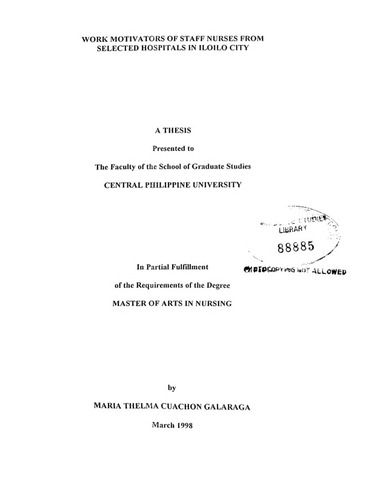Work motivators of staff nurses from selected hospitals in Iloilo City
Abstract
The main objective of the study was to determine the work motivators of the staff nurses from selected hospitals in Iloilo City. More specifically, this study aimed to determine if there were significant differences in the staff nurses’ descriptions of their work motivators, Achievement, Affiliation, Control, Dependence, Extension and Influence when the staff nurses were grouped according to the variables age, sex, work experience in years, monthly income, type of hospital employed in, unit of assignment in the hospital employed in, civil status, and educational attainment and also to determine if there were significant relationships among the six work motivators,
This study was conducted in selected hospitals in Iloilo City. The respondents were 196 staff nurses who were regular employees from their respective hospitals. The research instrument is a revised and modified standardized rating scale designed by Udai Pareek to measure work motivators.
The findings based on characteristics were the following: on the average, the respondents were female in their early thirties. Predominantly single, they have worked for about seven years as nurses. Their average monthly income is 7581.15 pesos. Almost half of them worked in a public hospital and the other half in a private hospital. A majority of them worked in the special areas like the ER, OR and ICU’s among others. The nurses were BSN degree holders with only a few having some units towards MAN.
The work motivators Achievement, Affiliation, Control, Dependence, and Extension were described by the respondents as a group to be Marginal. The other, motivator Influence was described as Moderately Strong. When grouped according to the selected variables mentioned, there were similar categorical descriptions as to when the respondents were grouped as a whole. However, when the t-test was applied to compare the two groups’ in means, there were significant differences on the following:
1. There were statistically significant differences in the respondents’ descriptions of the work motivators, Achievement, Affiliation and Control when grouped according to age, either 26 years old and below or above 26 years old.
2. There were statistically significant differences in the respondents’ descriptions of the work motivators, Achievement, Affiliation, and Control when grouped according to sex, either male or female.
3. There were statistically significant differences in the respondents’ descriptions of the work motivators, Achievement, Affiliation, Control, Dependence and Extension when grouped according to work experience, either less experienced or more experienced.
4. There were statistically significant differences in the respondents’ descriptions of the work motivators, Achievement, Affiliation and Control when grouped according to monthly income, either low or high.
5. There were statistically significant differences in the respondents’ descriptions of the work motivators, Achievement, Affiliation, Control and Dependence when grouped according to type of hospital employed in. either public or private.
6. There were no statistically significant differences in the respondents’ descriptions of the work motivators, when grouped according to unit of assignment in the hospital employed in, either nonspecial areas or special areas.
7. There were statistically significant differences in the respondents’ descriptions of the work motivators, Achievement and Control when grouped according to civil status, either single or married.
8. There were no statistically significant differences in the respondents’ descriptions of the work motivators, when grouped according to educational attainment, either BSN degree holders or others.
In order to determine for a statistically significant relationship among the work motivators, the Zero Order Correlation Coefficient (Pearson’s r) was applied and thus the results: There were slight or low correlation between, the work motivators, Achievement and Dependence, Affiliation and Extension and Control and Influence.
In the light of the significant findings of the study, the following conclusions were drawn:
1. The primary work motivator of the nurses was Influence, while the secondary work motivators were Achievement, Affiliation, Control, Dependence and Extension.
2. The nurses’ descriptions of the work motivators did not vary when grouped according to selected characteristics as when the nurses were grouped as one. All five work motivators were Marginal and only Influence was Moderately Strong.
The nurses’ descriptions of the six work motivators did not vary in descriptive category, despite their means having differences, when grouped according to selected characteristics. But when the t-test was applied, statistically significant differences were noted in some of the work motivators that were described as Marginal.
a. Achievement is a stronger motivator for the nurses belonging to the age group, above 26 years old, than for the younger nurses; for the married nurses than for single nurses; for the female nurses than for the male nurses; for the nurses belonging to the higher income bracket than for those in the lower income group; for the nurses from the public hospital than for those working in the private hospital; for those having more working experience than for those with less experience.
b. Affiliation is a stronger motivator for the nurses belonging to the age group, above 26 years old, than for the younger nurses; for the female nurses than for the male nurses; for the nurses belonging to the higher income bracket than for those in the lower income group; for the nurses from the public hospital than for those working in the private hospital; those having more working experience than for those with less experience.
c. Control is a stronger motivator for the nurses belonging to the age group, above 26 years old, than for the younger nurses; for the married nurses than for the single ones; for the female nurses than for the male nurses; for nurses belonging to the higher income bracket than for those in the lower income group, for nurses from the public hospital than for those working in the private hospital; for those having more working experience than for those with less experience.
d. Dependence is a stronger work motivator for nurses from the public hospital than for those working in the private hospital; for those having more working experience than for those with less experience.
e. Extension is a stronger work motivator for nurses having more working experience than those with less experience.
f. The nurses when grouped according to selected characteristics are equally motivated by Influence.
3. In terms of relationship among the work motivators, though only having low or slight correlation, the nurse who is concerned with excellence, competition with the standards of excellence set by others or by oneself, the setting of challenging goals for oneself, awareness of the hurdles in the way of achieving those goals and persistence in trying alternative paths to one’s goals, one tends to seek the help of others in one’s own self development, checking with significant others or those more knowledgeable or those who have higher status or are experts ( Achievement and Dependence) , when one has concern for others and interest in superordinate goals including society, one tends also have desires for friendly and close interpersonal relationships (Affiliation and Extension), and a person who is concerned with making an impact on others, a desire to make people do what one thinks is right and an urge to change matters and develop people will seek a concern for orderliness, a desire to be and stay informed and an urge to monitor and take corrective action when needed
The following recommendations were suggested:
1. It is recommended that a reevaluation of the factors contributing to organizational climate and motivation, such as job satisfaction, reward, morale among others might be reviewed and studied to establish causes for the marginal motivation.
2. It is suggested that they actually use the instrument for periodic evaluation of work motivation so that the employees can be sustained and monitored to be more effective in their jobs. The hospital managers can reassess their capacities to find ways and means to help nurses improve their level of work motivation. For the nurses’ spirit of openness to improve and be at their best as employees and caregivers, they need to be recognized and rewarded, in a way that will make a difference to them.
3. The nurse managers or the hospital managers for that matter need also to update themselves of new strategies to meet the needs of the staff. They must be enriched with the necessary competence and skill to foster personnel or human resources development. Thus, periodic professional training and development programs for the managers be conducted for this purpose
4. Sensitivity awareness, training and development programs to attune the nurses with their motivations at work are recommended.
5. The head nurses or supervisors may conduct personal evaluation sessions, feedback plus counselling if necessary, periodically on specific ways to address the staff nurses’ needs to improve and strengthen their level of motivation, subsequently their work output.
6. Further studies are recommended to be made on the work motivation of student nurses, who will actually be the staff nurses in the future; the clinical instructors, who are the mentors of the future professional nurses and even nurses employed in other work settings. Also, studies on the motivations of managers, the head nurses and supervisors themselves, as they are imperatively influential in providing help to their staff.
7. It is recommended that when the head nurses are appropriating tasks for the nurses and administrators thinking over a new policy, the findings of the study may be considered. Female, more experienced, married, older, high income earning nurses tend to have been more motivated than their group counterparts.
8. A study comparison of the work environment or the organizational climate between the private and public hospitals is recommended to be made.
Description
Abstract only
Suggested Citation
Galaraga, M. T. C. (1998). Work motivators of staff nurses from selected hospitals in Iloilo City (Unpublished Master's thesis). Central Philippine University, Jaro, Iloilo City.
Type
ThesisSubject(s)
Keywords
Department
School of Graduate StudiesDegree
Master of Arts in NursingShelf Location
GSL Theses 610.73072 G131
Physical Description
xiv, 139 leaves




